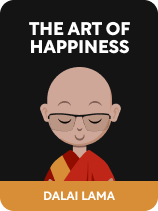

This article is an excerpt from the Shortform book guide to "The Art of Happiness" by Dalai Lama. Shortform has the world's best summaries and analyses of books you should be reading.
Like this article? Sign up for a free trial here .
What is the Dalai Lama and Howard C. Cutler’s book The Art of Happiness about? What’s the key message to take away from the book?
The Art of Happiness presents the Dalai Lama’s Buddhist approach to achieving greater happiness in life. Happiness, he says, isn’t something that happens to lucky people and eludes the unlucky: It’s something you can—and should—actively work to increase in your life.
Here’s our review of The Art of Happiness by Dalai Lama and Howard C. Cutler.
About the Authors
His Holiness the 14th Dalai Lama was born in 1935 in Tibet and, at the age of two, was declared to be the reincarnation of the previous Dalai Lama. Dalai Lamas are Bodhisattvas: enlightened beings who commit to being reborn over and over to help humans achieve enlightenment. His Holiness received a Buddhist education and the highest degree in Buddhist philosophy at age 23.
Traditionally, Dalai Lamas are both the political and spiritual rulers of Tibet, and the 14th Dalai Lama served in both capacities from 1950 to 2011. At the start of this period, China invaded Tibet, and the Dalai Lama was forced to flee and live in exile in Dharamsala, India, where he still lives. From Dharamsala, the Dalai Lama pursued peace efforts and in 1989 was awarded the Nobel Peace Prize for his work toward freeing Tibet. The Dalai Lama retired from political duties in 2011 and passed political authority to an elected leader. He remains the spiritual leader of Tibet.
Howard C. Cutler is a psychiatrist and author based in Phoenix, Arizona. Cutler first met the Dalai Lama in 1982 while studying Tibetan medicine in Dharamsala, India, where the Dalai Lama lives. After their initial meeting, Cutler was impressed by the Dalai Lama’s capacity for kindness and happiness, and the two remained in contact until Cutler asked the Dalai Lama to work on this book with him in 1993. Now, Cutler works as a speaker and teacher, giving courses based on The Art of Happiness.
Connect with Howard C. Cutler and the Dalai Lama:
- The Art of Happiness Website
- The Dalai Lama’s Twitter
- The Dalai Lama’s Instagram
- The Dalai Lama’s Facebook
- The Dalai Lama’s Website
The Book’s Publication
Publisher: Penguin Random House
This guide covers the 10th Anniversary Edition of The Art of Happiness, published in 2009. The Dalai Lama wrote a new preface, and Cutler wrote a new introduction.
Intellectual Context
Publication of The Art of Happiness coincided with the emergence of happiness as a field of scientific study. The book, along with formal scientific research, helped introduce the West to the idea that you can foster happiness—that it’s not just luck of the draw. This idea has since taken root in politics, medicine, pop culture, and many other realms of life. The ever-growing body of scientific work on happiness, which includes books like The Happiness Hypothesis and The Happiness Advantage, shows this wave is still going strong.
The Book’s Impact
The Art of Happiness introduced Westerners to the Dalai Lama and Buddhism in a substantial way. Up until its publication, Cutler says Americans were familiar with the Dalai Lama but not his spiritual teachings.
According to Cutler’s 2009 introduction, the book was on the New York Times bestseller list for two years and was woven into the fabric of pop culture, appearing in shows like Friends, Sex and the City, Who Wants to Be a Millionaire, MTV Cribs, and Jeopardy!.
Since its publication, Cutler and the Dalai Lama have worked on two other books together: The Art of Happiness at Work (2003), and The Art of Happiness in a Troubled World (2009).
Critical Reception
The Art of Happiness reviews have been very positive—readers appreciate how simple and unpretentious the Dalai Lama’s advice for being happy is. He doesn’t offer a program that guarantees bliss, but rather simple, almost obvious ways to slowly and surely grow the seed of happiness in your life.
Some critics, though, felt that the temperature of the advice was lukewarm and didn’t have the power to sway anyone. Some also disagree fundamentally with the book’s premise that our purpose in life is to be happy.
Commentary on the Book’s Approach
The Art of Happiness is presented as a meeting of Eastern spirituality and Western science. It’s predicated on the idea that you need both science and spirituality to live your best life.
Cutler stresses the value of Buddhist thought by stating that Buddhism is based on observable truth—in other words, on lived human experience, rather than on faith, like other religions. The Dalai Lama’s previously said, for example, that if science were to ever show a Buddhist belief to be empirically incorrect, then that belief would have to be altered. Cutler adds that Buddhists have been reflecting on the best way to achieve happiness for 2,500 years and that such a long-standing tradition has likely developed accurate ideas around achieving happiness.
This book is not a results- or formula-driven self-help book, like Designing Your Life, for instance. Rather, it’s the Dalai Lama’s musings on or answers to Cutler’s questions on happiness, which Cutler loosely arranged into categories and chapters. You won’t read The Art of Happiness and come out with an action plan for happiness, but you’ll better understand what makes you happy and why and how you can begin to make shifts in your life to increase your happiness.
Cutler often presents ideas in the Dalai Lama’s own words, sometimes quoting him at length. Cutler then breaks down those ideas, giving concrete examples from his psychiatric practice, for instance, or connecting them to science, where appropriate.
Commentary on the Book’s Organization
Cutler groups the Dalai Lama’s advice into five parts that broadly cover: 1) the purpose of life, 2) relationships, 3) suffering, 4) adversity, and 5) spirituality. The parts are heavily structured, each containing chapters and chapter subheadings. Cutler likely structured the parts this rigorously because the ideas are expansive, are interconnected, and need to be corralled. Despite the structuring, you’ll still encounter the same ideas across many chapters—this is simply the interconnected nature of Buddhist philosophy.

———End of Preview———
Like what you just read? Read the rest of the world's best book summary and analysis of Dalai Lama's "The Art of Happiness" at Shortform .
Here's what you'll find in our full The Art of Happiness summary :
- The Dalai Lama's Buddhist path toward happiness
- The use of scientific evidence to support the Dalai Lama's beliefs
- Concrete actions you can take to improve your outlook on life, relationships, and resilience






